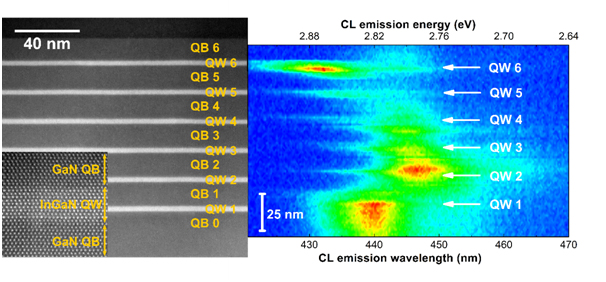Indium gallium nitride quantum well lighting emitting diodes (LEDs) have superior energy efficiency compared to traditional lighting. However, the presence of a strong electric field within the quantum wells which make up the light emitting region pushes the positive and negative charge carriers apart, slowing down the rate at which they recombine to produce light. This reduces the device efficiency. In this study, we use a recently-developed technique, "nanocathodoluminescence", to measure the colour spectrum of the light emitted from individual quantum wells, separating out the optical properties of different wells each of which is only a few nanometres in size. We observe a variation in the wavelength (or colour) of the emission which is a signature of the internal electric field and which we show can be manipulated by adding silicon dopant atoms to the barrier layers which separate the quantum wells. The experimental nanocathodoluminescence observations are reproduced by theoretical simulations, which reveal how the Silicon doping reduces the electric field in the quantum wells. This work demonstrates that nanocathodoluminescence is a powerful technique to optimise doping in optoelectronic devices.
Figure: Aberration-corrected STEM image of the quantum well structure and a magnified image of quantum well 1. The corresponding cathodoluminescence spectral profile across the QWs.
J.T. Griffiths, S. Zhang, B. Rouet-Leduc, W.Y. Fu, A. Bao, D. Zhu, D.J. Wallis, A. Howkins, I. Boyd, D. Stowe, M.J. Kappers, C.J. Humphreys, and R.A. Oliver, "Nanocathodoluminescence Reveals Mitigation of the Stark Shift in InGaN Quantum Wells by Si Doping", Nano Lett. 2015 Nov 11;15(11):7639-43

